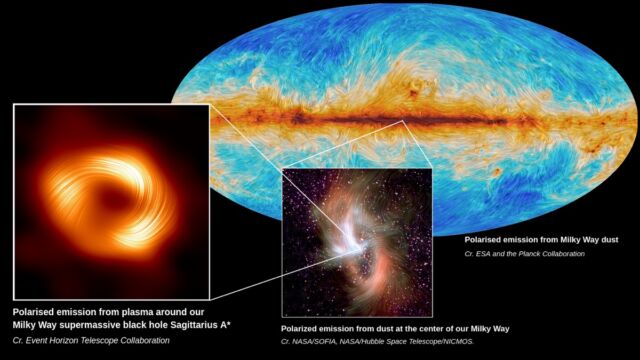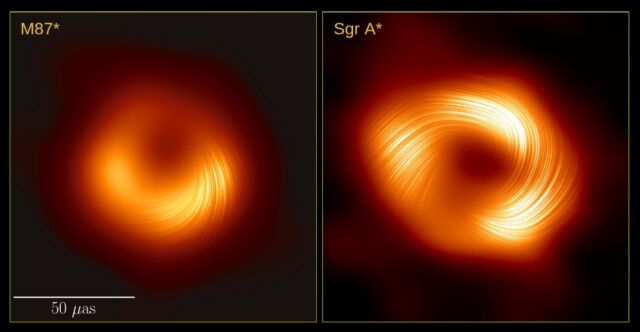
A new image from the Event Horizon Telescope has revealed powerful magnetic fields spiraling from the edge
of a supermassive black hole at the center of the Milky Way, Sagittarius A*.
EHT Collaboration
Physicists have been confident since the1980s that there is a supermassive black hole at the center of the Milky Way galaxy, similar to those thought to be at the center of most spiral and elliptical galaxies. It's since been dubbed Sagittarius A* (pronounced A-star), or SgrA* for short. The Event Horizon Telescope (EHT) captured the first image of SgrA* two years ago. Now the collaboration has revealed a new polarized image (above) showcasing the black hole's swirling magnetic fields. The technical details appear in two new papers published in The Astrophysical Journal Letters. The new image is strikingly similar to another EHT image of a larger supermassive black hole, M87*, so this might be something that all such black holes share.
The only way to "see" a black hole is to image the shadow created by light as it bends in response to the object's powerful gravitational field. As Ars Science Editor John Timmer reported in 2019, the EHT isn't a telescope in the traditional sense. Instead, it's a collection of telescopes scattered around the globe. The EHT is created by interferometry, which uses light in the microwave regime of the electromagnetic spectrum captured at different locations. These recorded images are combined and processed to build an image with a resolution similar to that of a telescope the size of the most distant locations. Interferometry has been used at facilities like ALMA (the Atacama Large Millimeter/submillimeter Array) in northern Chile, where telescopes can be spread across 16 km of desert.
In theory, there's no upper limit on the size of the array, but to determine which photons originated simultaneously at the source, you need very precise location and timing information on each of the sites. And you still have to gather sufficient photons to see anything at all. So atomic clocks were installed at many of the locations, and exact GPS measurements were built up over time. For the EHT, the large collecting area of ALMA—combined with choosing a wavelength in which supermassive black holes are very bright—ensured sufficient photons.
In 2019, the EHT announced the first direct image taken of a black hole at the center of an elliptical galaxy, Messier 87, located in the constellation of Virgo some 55 million light-years away. This image would have been impossible a mere generation ago, and it was made possible by technological breakthroughs, innovative new algorithms, and (of course) connecting several of the world's best radio observatories. The image confirmed that the object at the center of M87* is indeed a black hole.
In 2021, the EHT collaboration released a new image of M87* showing what the black hole looks like in polarized light—a signature of the magnetic fields at the object's edge—which yielded fresh insight into how black holes gobble up matter and emit powerful jets from their cores. A few months later, the EHT was back with images of the "dark heart" of a radio galaxy known as Centaurus A, enabling the collaboration to pinpoint the location of the supermassive black hole at the galaxy's center.
SgrA* is much smaller but also much closer than M87*. That made it a bit more challenging to capture an equally sharp image because SgrA* changes on time scales of minutes and hours compared to days and weeks for M87*. Physicist Matt Strassler previously compared the feat to "taking a one-second exposure of a tree on a windy day. Things get blurred out, and it can be difficult to determine the true shape of what was captured in the image."

(left) Sagittarius A* in polarized light. (center) Polarized emission from the center of the Milky
Way. (right) Map of polarized emission from dust across the Milky Way.
S. Issaoun, EHT Collaboration
The EHT collaboration finally announced the first image of SgrA* in 2022, showing that it has a ring structure. But astronomers still didn't know how the Milky Way's supermassive black hole is oriented or how fast it is spinning. That image was based on the same 2017 data as the image of M87*; it just took much longer to process. While M87* was an easier, steadier target, with nearly all images looking the same, that was not the case for SgrA*. The 2022 image was an average of the different images from observational data that the team collected over the course of multiple days. It took five years, multiple supercomputer simulations, and the development of new computational imaging algorithms capable of making inferences to fill in the blanks in the data.
Having EHT images for two black holes—one at the large end and one at the small end of supermassive black holes in the Universe—enables astronomers to compare the two. The 2022 SgrA* image was so remarkably similar to M87* that astronomers wanted to learn more about what else the two objects might have in common on top of their general appearance. So they set out to capture an image of SgrA* in polarized light—a feat even more challenging than getting that first image in "normal" light.
"We were relieved that polarized imaging was even possible," said co-author Geoffrey Bower of the Institute of Astronomy and Astrophysics at Academia Sinica in Taiwan. To do so, the collaboration linked eight different telescopes around the world, including the aforementioned ALMA and the Atacama Pathfinder Experiment (APEX), also in northern Chile.

M87* and Sgr A* side by side in polarized light
EHT Collaboration
"With a sample of two black holes—with very different masses and very different host galaxies—it’s important to determine what they agree and disagree on," said Mariafelicia De Laurentis of the University of Naples Federico II, in Italy. "Since both are pointing us toward strong magnetic fields, it suggests that this may be a universal and perhaps fundamental feature of these kinds of systems.” The EHT will start observing SgrA* again next month, and future expansions should incorporate enough new telescopes to produce high-fidelity movies of the black hole.
Given the similarities, astronomers suspect there could be a hidden jet lurking somewhere in SgrA* and further imaging could reveal it, as well as shed light on how neutrinos or cosmic rays can reach such high energies. "There’s this really exciting hint that there may be some additional structure,” co-author Ziri Younsi of University College London told New Scientist. “There might be something going on that’s quite exciting in the center of the galaxy, and I think that these results we’re going to need to follow up. The magnetic fields are the bedrock of all of this. Anything which gives us more insight into how black holes and magnetic fields interact is just foundationally important for astrophysics.”
Astrophysical Journal Letters, 2024. DOI: 10.3847/2041-8213/ad2df0
Astrophysical Journal Letters, 2024. DOI: 10.3847/2041-8213/ad2df1 (About DOIs).
Listing image by EHT Collaboration




3175x175(CURRENT).thumb.jpg.b05acc060982b36f5891ba728e6d953c.jpg)


Recommended Comments
There are no comments to display.
Join the conversation
You can post now and register later. If you have an account, sign in now to post with your account.
Note: Your post will require moderator approval before it will be visible.